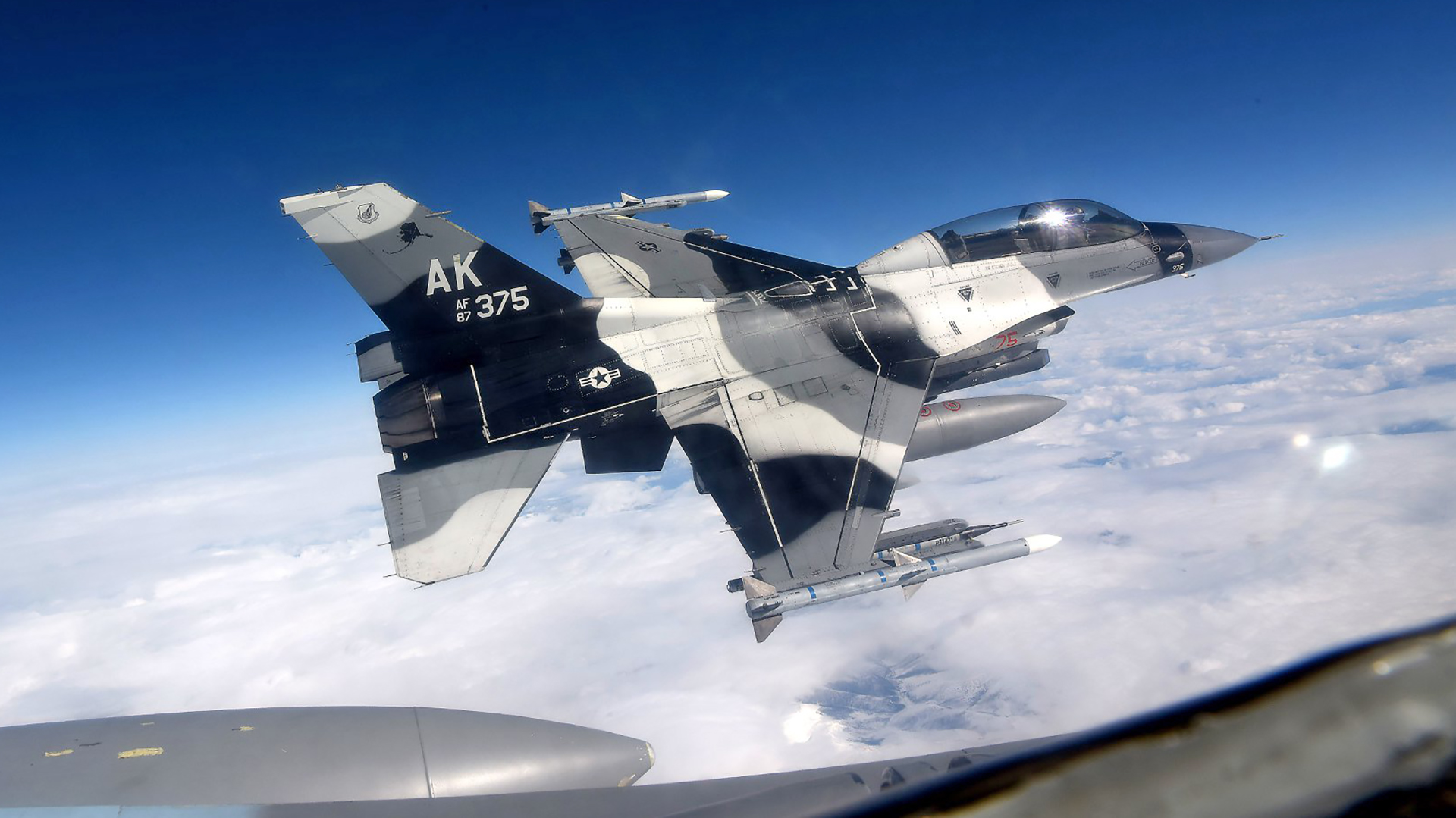A four-ship formation of F-15E Strike Eagles is corralled into a classic ‘wall’ — a wide formation of jets — working alongside a four-ship of F-35 stealth fighters. The flight lead orchestrates the team while sucking down big gulps of oxygen from their mask in preparation for a serious aerial dust-up against the ‘enemy.’ On the radar and datalink ‘picture’ are four Russian Su-57 Felons, 12 Chinese J-20s, and a swathe of marauding bombers. Just about as tough an opponent as a flight of F-15s could ask for — and that’s without factoring in the complex integrated air defense system with lethal S-400 surface-to-air missiles that further complicates the mission ahead.
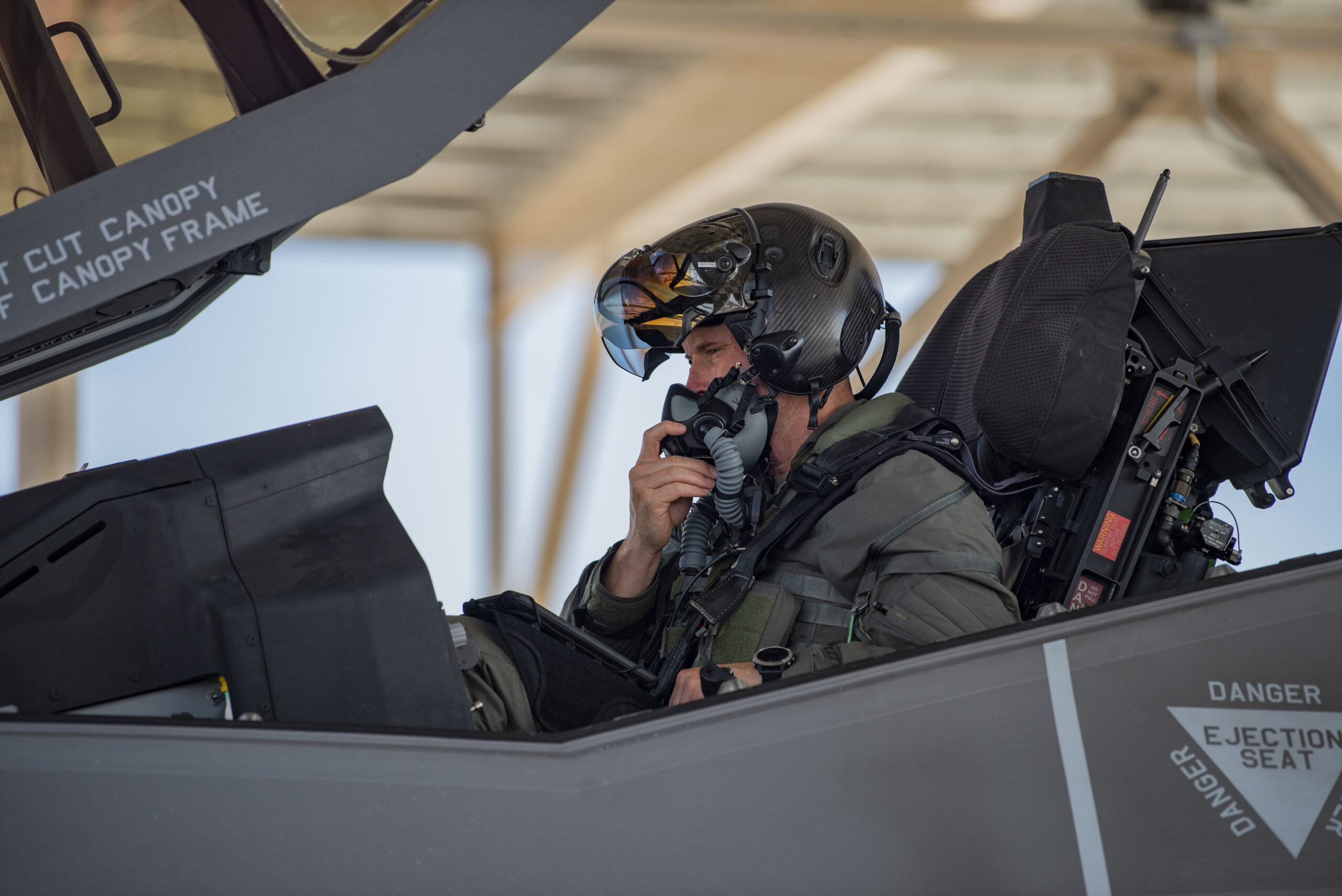
From the stress-filled cockpits of the blue air (friendly) Strike Eagles, the red air opponents look and behave as if they are all real-world bad guys on the fighters’ radars and electronic warfare systems. Even the clever non-cooperative target recognition (NCTR) system that uses the radar to definitively identify long-range foes is telling the Eagle crews that these are real targets, behaving exactly as these aircraft would in the real world. If red air is able to launch weapons at the Eagles, the engagement zones would be exactly as intelligence experts predict.
But all is not what it seems. The F-35s are fellow blue air assets, but the pilots are in sitting on the ground in Distributed Mission Trainers that are linked into the common synthetic environment alongside the live F-15Es. The four Su-57 Felons are actually U.S. Air Force F-16 aggressors, cleverly masquerading, or ‘guising,’ as high-end Russian fighters. Four of the J-20s are contract-aggressor Mirage F1s, while the other eight are actually aggressor pilots in a virtual world, in ground-based simulators back at base. Moreover, the bombers are computer-generated entities — ‘constructives’ — pre-programmed by experts in a classic bomber attack formation. While the Strike Eagles actually face a mix of live and synthetic opponents, the information flowing to the crews doesn’t discern between the two — the opposition all appears to be very real and very deadly.
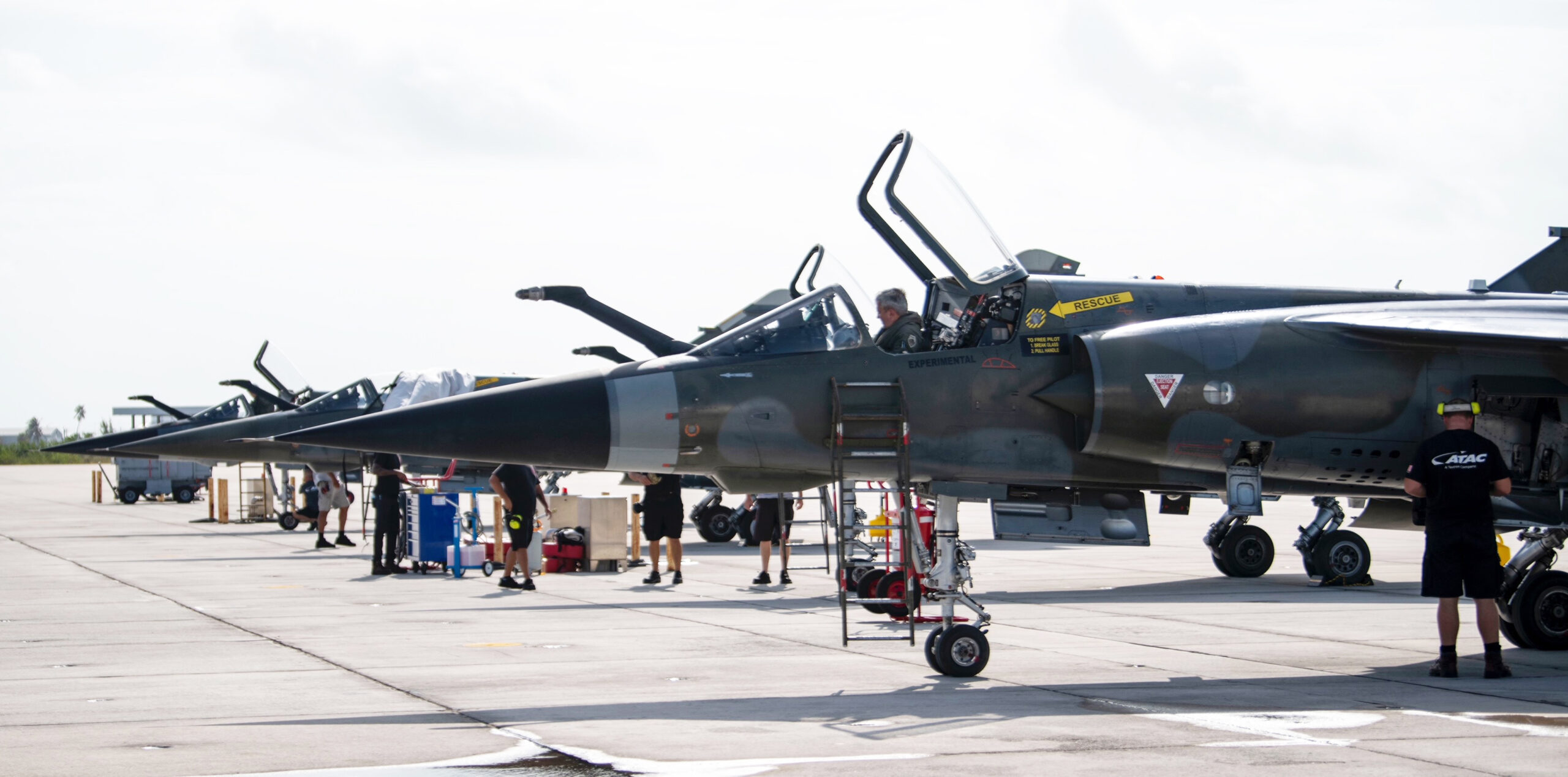
The need to challenge advanced fourth- and fifth-generation fighter aircraft with large, complex, and realistic opposing forces is growing fast. As fighters expand in capability, they require more effective, affordable opposition that better represents modern-day threats. Not to mention huge swathes of airspace in which to go about this business. While some point to increased use of simulators for training, most agree that this cannot be at the expense of live flying. A blend of the two is emerging as a preferred solution. While endless formations of enemy jets can be generated in a simulator, live, virtual, constructive (LVC) technology is a key enabler to blending live flying with the computer world.
Cubic Corporation has been at the heart of fighter training for decades. The company’s Paul “Pk” Averna is a former U.S. Navy F-14 Tomcat pilot and graduate of the famous TOPGUN school. He is a subject matter expert in this type of training with Cubic’s Mission and Performance Solutions and is well versed in the challenges of modern aerial combat training.
“We need to start back in the 1970s,” says Averna. “In training, particularly for air-to-air prior to the early 1970s when we lacked instrumentation, it was really about perspectives from individual cockpits to evaluate what happened in a training event. That’s a myopic view, particularly as younger aircrews tend to get focused on what’s happening directly in front of them on their head-up displays, on their instruments, and what they are hearing. It’s not always 100 percent correct. So the value of learning in the debrief was always subject to the perspectives of the participants.”

“When we introduced Air Combat Maneuvering Instrumentation, or ACMI, pods back in the early 1970s for TOPGUN with a system that Cubic created at Marine Corps Air Station Yuma, in Arizona, we were able to track eight aircraft and observe them in real-time. From a debriefing perspective, it meant we were able to show exactly where every aircraft was and included their missile shot calls. Often, the opponent was nowhere near the weapon’s field of regard — so that would be an invalid shot — the crew hadn’t perceived the situation correctly. So, ACMI immediately brought truth to our training.”
Since the early iteration of ACMI, the podded Cubic tracking system has been massively improved to the current P5 standard. The system transmits encrypted time, space, and position information. This can cater to up to 120 participants and provide a complex battle debriefing tool, including live monitoring via downlink to a God’s eye view on the ground. The U.S. and 17 coalition partner nations utilize Cubic ACMI at 30 different range complexes across the globe, with the system requiring a combination of instrumentation towers on ranges and the podded tracking systems on the aircraft, similar in size and shape to an AIM-9 Sidewinder missile. The F-35 carries the P5 system internally and provides encrypted time/space/position data to preserve the security of its sensitive capabilities.
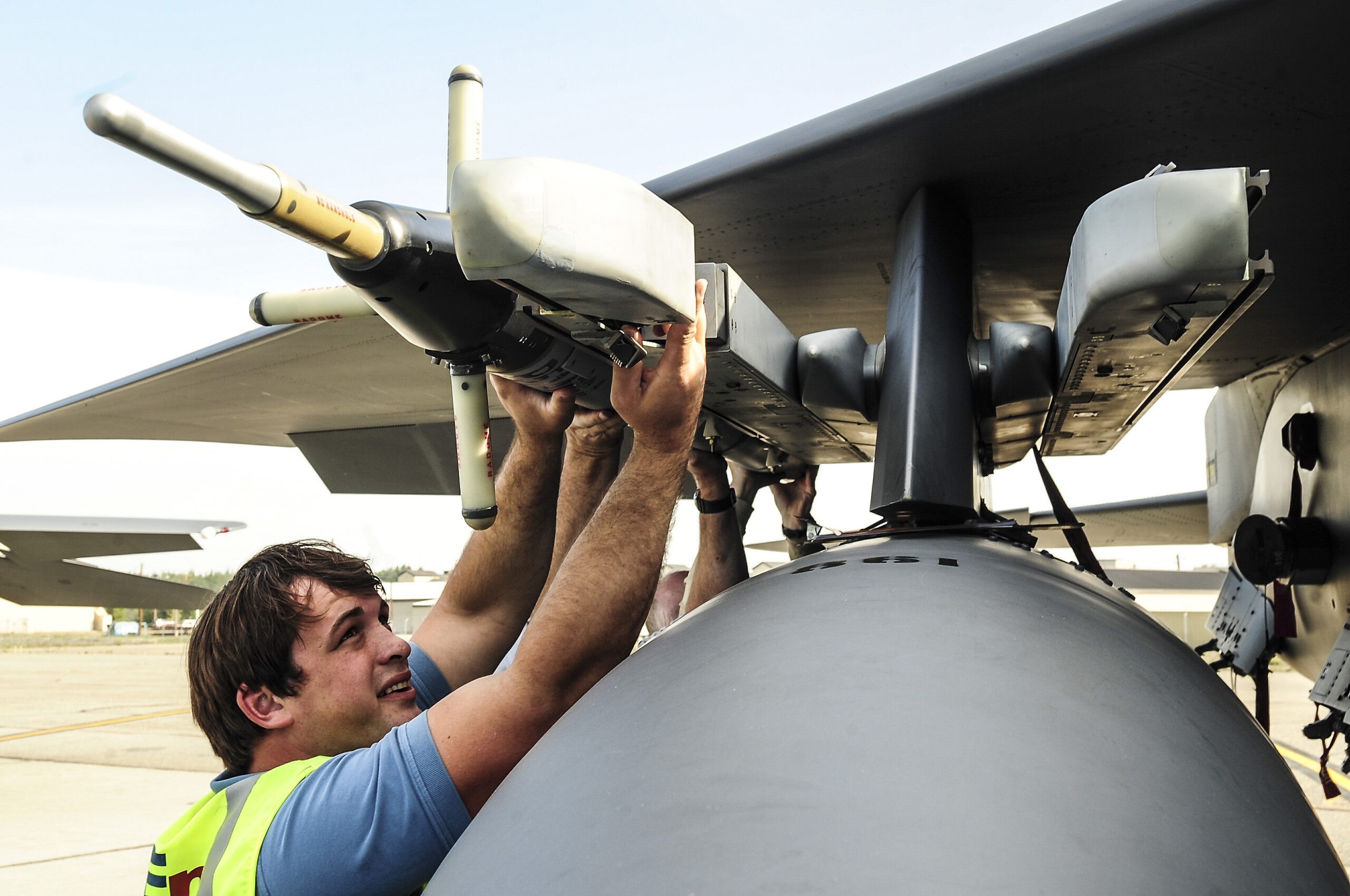
Coincident with the increased capabilities of platforms and adversaries comes the advent of net-enabled weapons, advanced sensors, and the ability to employ different effects in many different ways. Aircraft such as the F-35 can integrate huge amounts of sensor information into a coherent picture. “In the past, various aircraft worked on existing training ranges, practiced coordinated strikes, and went against relatively unsophisticated threat replication,” explains Averna. “With the advent of fifth-gen and the evolution of real-world threats, this has dramatically changed.”
“With the F-35, the effects that can be generated and its overall influence in the battlespace have greatly exceeded our physical training ranges. It’s not just about the capabilities of the blue forces being able to project outside the physical training ranges, but the red air is rapidly advancing as well to match these real-world threats. Today’s counter-air and counter-surface battle calls for a complicated and sophisticated adversary with a high capability, high capacity, threat environment, and this is something that we cannot currently replicate on our current physical ranges. So how do we address this problem?”
“In the mid-2000s we started looking at the benefits of simulators and computer-generated constructive ‘players’ working together to offer the flexibility of a virtual range where we have no boundaries and better replication of a peer adversary and bring the live component into that mix. There was a series of projects that started in the late 2000s, starting with Project Alpine [a Boeing-led research project that tested a real F-15E operating with an F-15E simulator on the ground and encountering simulated and constructive threats], and this ultimately led to the Secure Live Virtual Constructive Advanced Training Environment, SLATE, advanced technology demonstration [ATD] that kicked off in 2015 and finished up in 2018,” Averna explains.
“The SLATE ATD was created when the then chief of Air Combat Command, General ‘Hawk’ Carlisle, acknowledged that the trajectory being pursued with regard to the instrumentation of training systems, was not sufficient for fifth-generation aircraft. Carlisle wanted to verify if it was possible to create an LVC [with ‘virtual’ ground simulators and ‘constructive’ computer-generated models of the enemy] training environment to support both fourth- and fifth-gen training needs and do that using SLATE.”
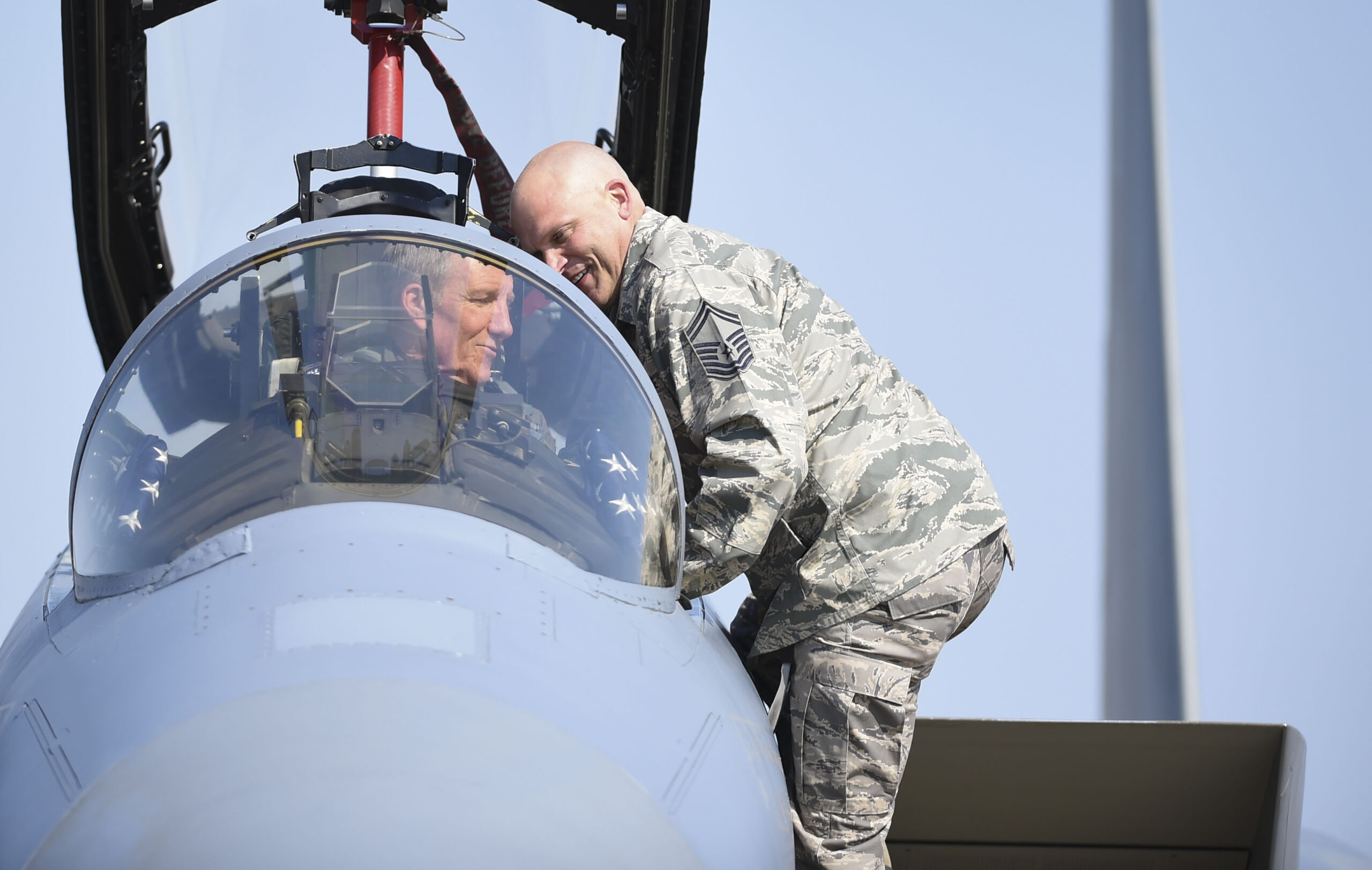
The Air Force Research Laboratory (AFRL) led the SLATE ATD with Cubic as the lead systems integrator, in partnership with Boeing and other supporting contractors. One of the biggest hurdles in partnering live flying with ground-based simulators was latency in the system, which needed to be so minimal that crews in the air couldn’t discern what was live, what was virtual, and what was constructive.
Such was the complexity in terms of the technology that the first actual SLATE ATD flight took place in the last six months of the 40-month effort. This initially involved F-16s ‘guising’ as threat aircraft in participating F-15Es’ cockpits. In a final Phase III capstone demonstration event held at Nellis Air Force Base, Nevada, in September 2018, Cubic was able to include eight live F-15Es, eight live F/A-18 Super Hornets, two live F-16s, two F-16 and two F/A-18 simulators, and hundreds of constructives in a large force exercise where the red air participants were ‘guised’ as threat aircraft. And all of this was connected through a highly secure virtual environment.
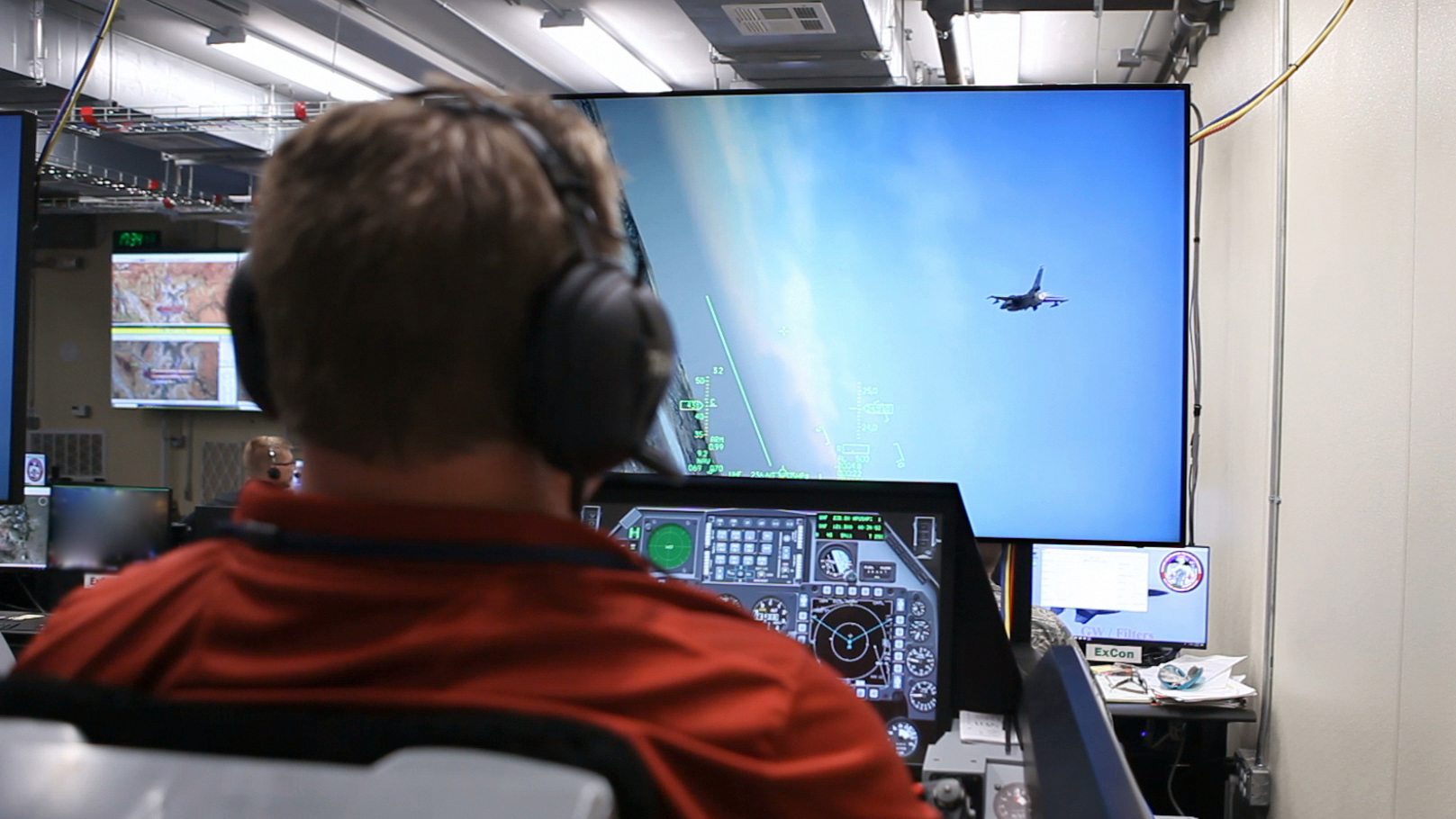
‘Guising’ is a critical element of the SLATE system. A red air aircraft’s SLATE pod can communicate with a blue air F-15, for example, carrying the same type of pod, with SLATE ‘guising’ that red fighter as something completely different. For example, an F-16 with SLATE can ‘guise’ as a J-20, which means all the F-15 cockpit indications — radar, radar warning receiver, datalink, infrared search-and-track — would show that F-16 as a J-20. With SLATE, it could also have a formation of constructive J-20s around it. When it comes to a large force exercise, all of the force elements on the SLATE system see the same picture, and it’s all securely transmitted, in real-time. The blue air F-15 carrying the SLATE pod knows that ‘enemy’ aircraft is to be guised, and the sensors portray that. Even if a pilot commanded a Non-Cooperative Target Recognition (NCTR) radar mode, it would tell the pilot “that is a J-20 — not an F-16.”
“Traditionally, when we train for a BVR [beyond visual range] intercept, the red air will approximate what the enemy can do,” explains Averna. “The pilot sees that aggressor F-16 as an F-16 on the sensors — they have to pretend it’s a Su-57 or J-20. How realistic is that, aside from basic timeline management fundamentals? With a SLATE pod and that F-16 guising as a J-20, for example, the blue air pilot won’t see the target on their systems until the detection range of a J-20 because the jet isn’t allowed to display that information on the screen until it’s the right time. When it does display, it appears as a J-20.”
“So that’s a realistic perspective on detection range, and a realistic perspective on potential effects — weapons and weapons fly out. We can augment that with a virtual or constructive participant to provide both threat density and realism.” From a security perspective, no one outside the loop knows what the training is — it’s all in the cockpit. The LVC processor in the pod overrides what’s real and what isn’t and blends the two together so that when a pilot is moving from a BVR fight, into close range, the real aircraft, carrying a SLATE pod, is there to merge and dogfight with.
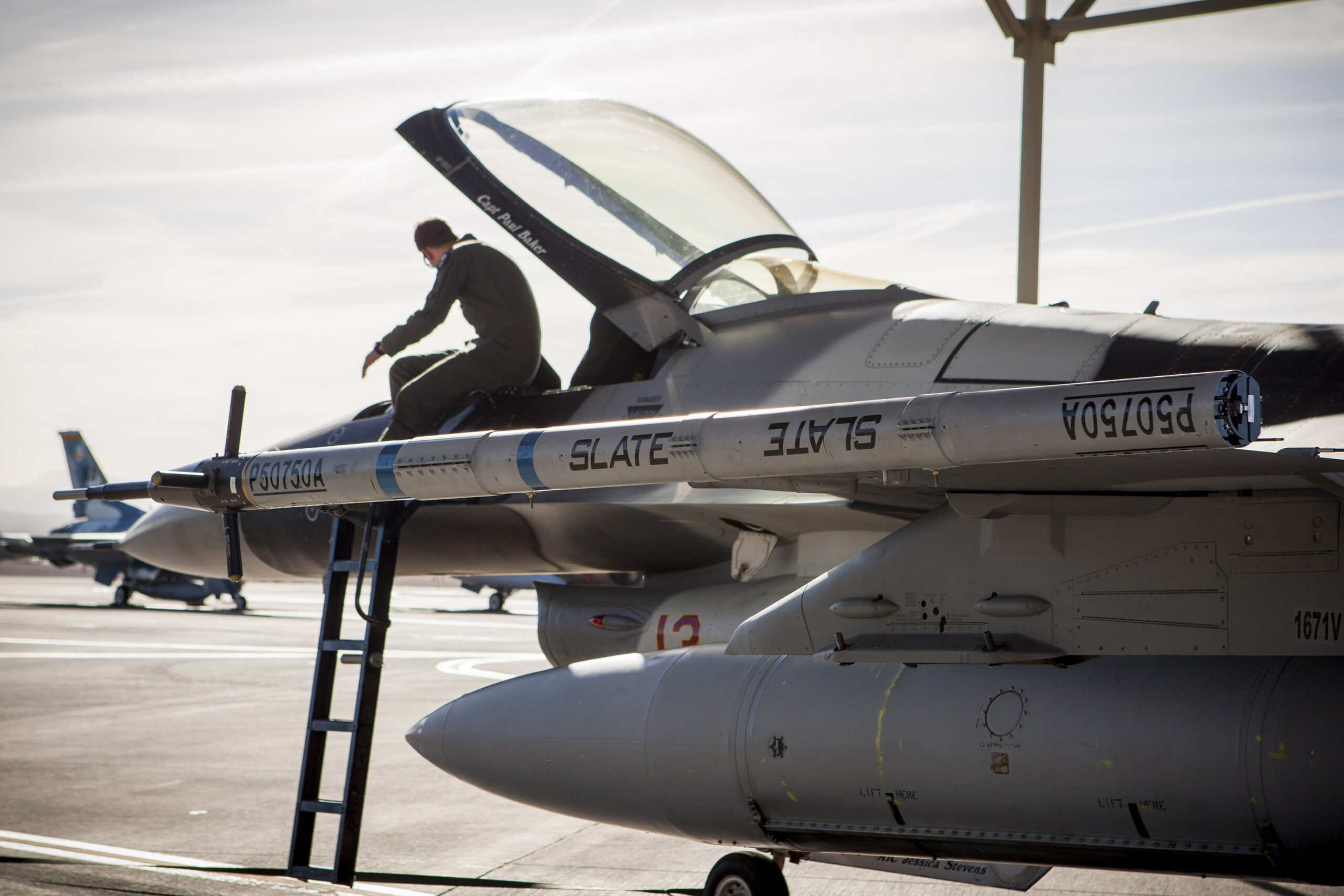
“This training capability will allow pilots to train like they fight against realistic threats in a secure, high-fidelity training environment by combining synthetic and real-world air combat training,” explained Dr. Winston “Wink” Bennett, of the AFRL, in an Air Force media release. “Until the SLATE demonstrations, there were only limited and constrained LVC integrated evaluations. The three phases of SLATE allowed us to fully demonstrate technical capabilities and alternatives to reduce risk for LVC as a future readiness concept.”
“One of the things we demonstrated was something we call “untethered LVC,” Bennett explained. “What untethered allows us to do is conduct realistic live and constructive training anywhere we need to. This is because the modified aircraft and pods can host and distribute specific scenarios we can program into the pods with or without a range infrastructure. Moreover, we were able to demonstrate in Phase III that the untethered mode can supplement their actual live training even if the range infrastructure goes down or air-to-ground infrastructure slows down. One of the aircraft can serve as the host and the other aircraft as clients, but they can all see and tactically work through the same scenario in real-time anywhere.”
“There are two major pieces of SLATE,” explained Bennett. “The first is the secure piece — we want to be able to train realistically and not give away the things that make us the best in the world to the bad guys. So it has to be a secure way of transmitting information back and forth. The second major piece is the LVC. The live aspect is the military members actually flying in their operational airplanes, driving in their operational truck or vehicle on the ground, remotely piloted aircraft — they’re using their operational equipment. But we’re able to tie that to a virtual environment which is a simulation of that operational equipment. And the constructive environment which is computer-generated models and entities that allow us to create realistic threats, realistic bad guys, and behaviors that our folks can actually go after.”
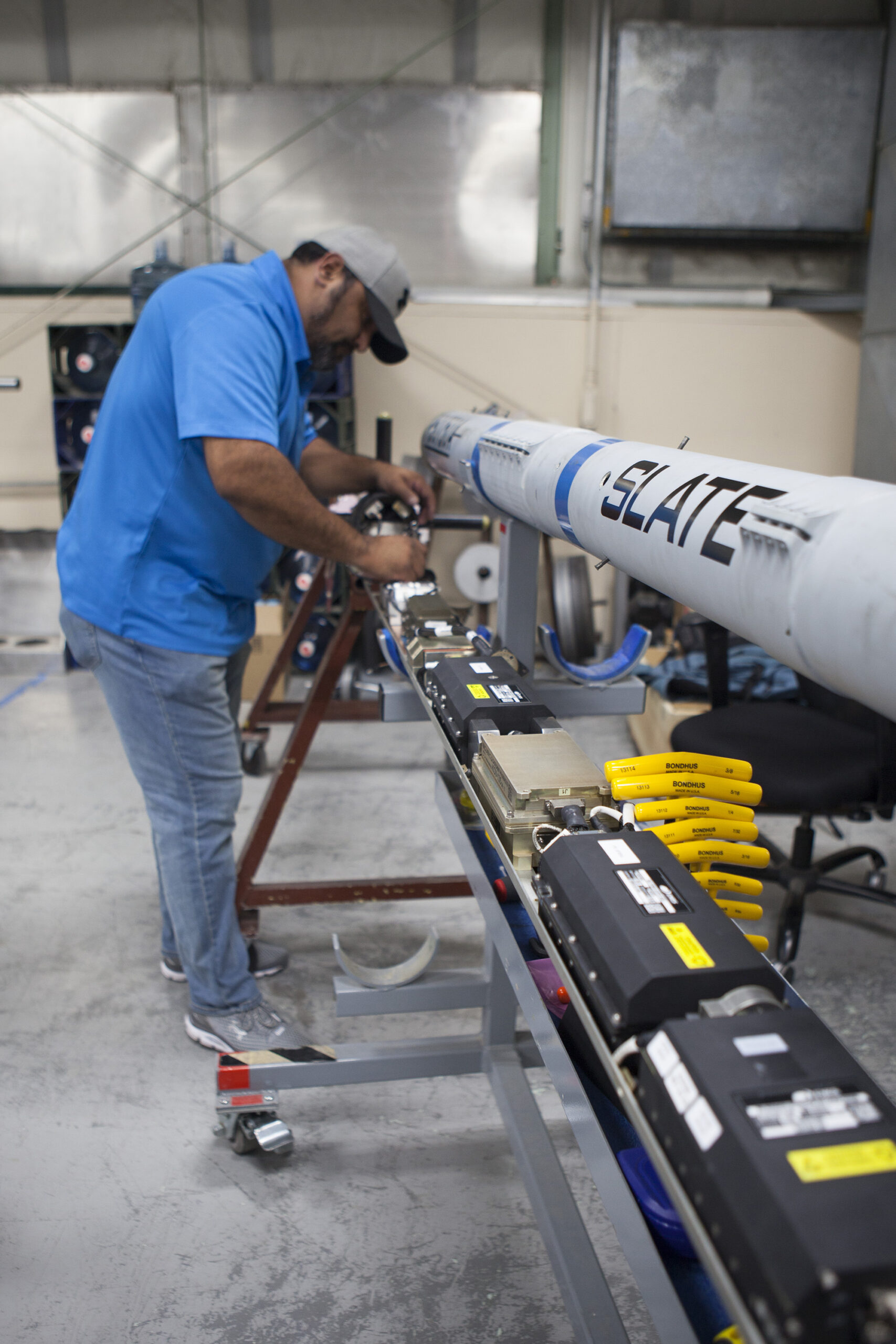
Embedded training modes in fighter aircraft is not new. The F-22 Raptor has a closed system with constructives only, meaning a four-ship can fly in airspace that is littered with fake SAMs, and can prosecute these. A Super Hornet can do basic BVR work — go after synthetic targets which in the early days of training in the airplane is considered to be sufficient to learn the hands-on throttle and stick controls and the weapons system.
The F-35 also has an embedded training system that can present air and ground targets. Embedded Combat Aircraft Training System (E-CATS) is designed to provide pilots with realistic and effective in-flight training. Jointly developed by Dutch Space and NLR, E-CATS resides inside the operational flight program. But it’s F-35-specific.
The beauty of SLATE is that it can work across different platforms. Any aircraft with a missile rail can carry a SLATE pod. However, the particular aircraft that the crew is training in must be configured for SLATE, the mission computer has to be configured to receive synthetic information from the system. Essentially, SLATE sneaks LVC data into the cockpit via the Operational Flight Program interface.
“To be a live player, to accept common protocols and standards, we used a distributed interactive language of simulators, with high-performance waveform datalinks for all participants,” explains Averna. “The live aircraft-to-ground-based simulator network has to work with very low latency, we are talking in the millisecond timeframe, so we can know if a missile is being pulled off target by expendables. The system includes models of all the entities out there, the platforms, the weapons, the sensor effects. It also includes infrared and electromagnetic properties — for example, an adversary looks different in full afterburner versus in military power on a forward-looking infrared sensor.”
To date, Cubic has worked in partnership with Boeing to embed SLATE into the latest OFPs for the F-15E [Suite 8] and Super Hornet [H14 System Configuration Set]. The F-35 is clearly an important platform for SLATE, and to date, the system is not integrated into this fighter. The Lightning II features a complex sensor fusion engine that differs from the fourth-gen OFPs. Averna says the F-35 Joint Program Office is looking to kick off a second-phase sensor fusion study to assess how the fighter would process the data.
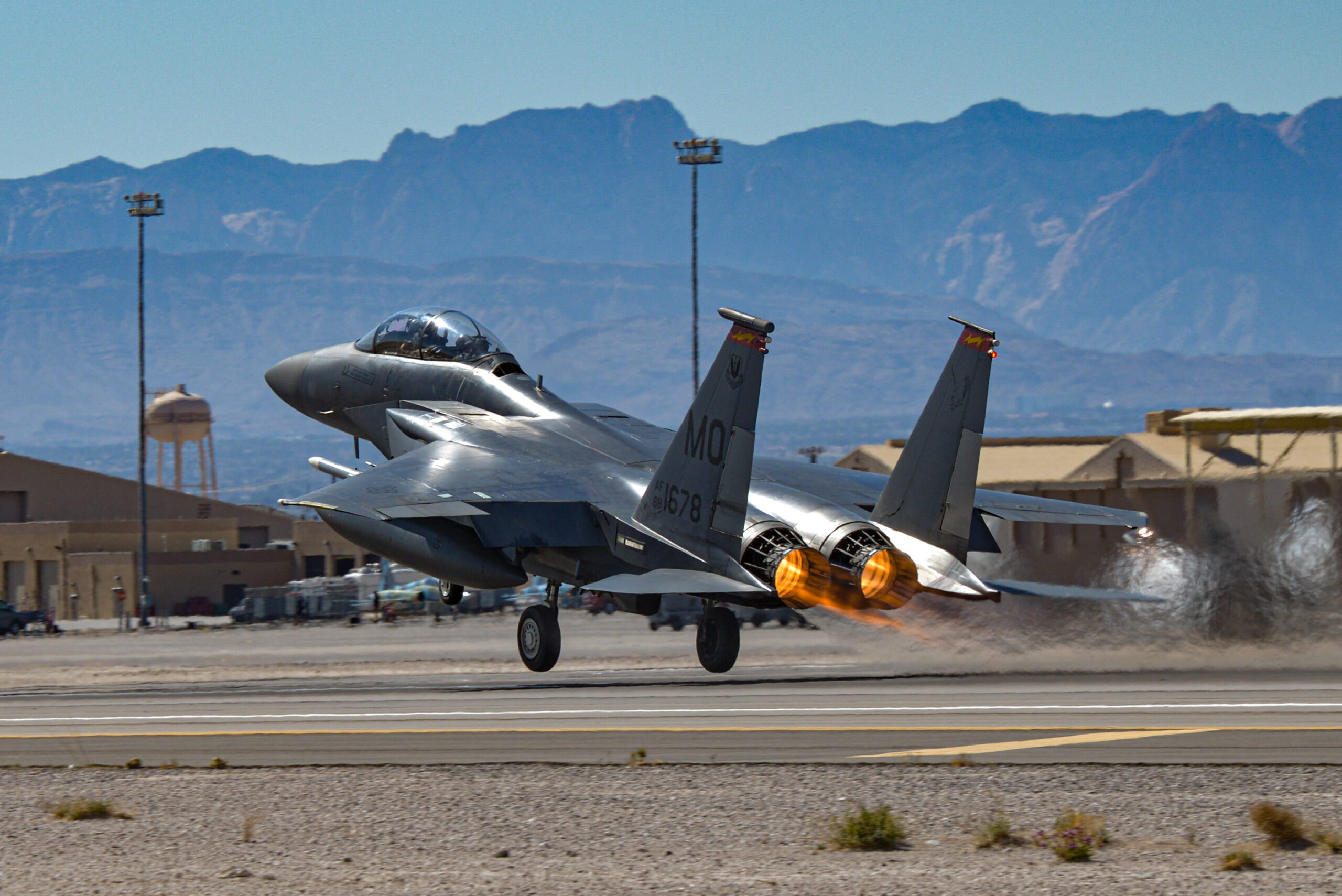
Following on from the SLATE ATD, in September 2021, the F/A-18 and EA-18G Program Office (PMA-265) completed a SLATE technology demonstration at Naval Air Station Patuxent River, Maryland. The event included four flight tests, supported by Air Test and Evaluation Squadron (VX) 23, Boeing, and Cubic. According to a U.S. Navy media release, the demonstration showcased the Synthetic Inject to Live (SITL) system’s maturity and performance in supporting training against near-peer threats, while validating its technology readiness level with the F/A-18E/F Super Hornet and EA-18G Growler. The SLATE system capabilities are planned to transition to the Navy’s Training Program of Record for the Tactical Combat Training System (TCTS) Increment II in the near future.
“The SITL LVC capabilities demonstrated by SLATE are essential to providing our warfighters with a complex and realistic training environment that promotes combat readiness,” said Megan Sullivan, PMA-265 SLATE Integrated Product Team lead. “The event’s completion informs planning and enables more rapid fielding to the fleet.”
“Building off the highly successful Joint Capstone event, conducted in 2018, at the Nellis Test and Training Range, the SLATE capability continues to pave the way for LVC training standards across the DoD. The 2021 technical maturation demonstration takes these capabilities to the next level by adding in cross-platform integration and utilizing common Navy systems,” said Sullivan.
“The SLATE flights also included the integration of the Navy’s Next Generation Threat System for both tethered and untethered operations; F/A-18E/F simulators; the F-35 Effects Based Simulator; Aegis Battle Force Tactical Trainers; and a fleet MH-60R tactical operational flight trainers at Naval Air Station Jacksonville, Florida, via the Navy’s Continuous Training Environment. Virtual and constructive radar tracks were observed and confirmed in the live cockpit by the supporting VX-23 aircrew during debrief,” Sullivan said.
In addition, the Royal Australian Air Force participated in the 2021 SLATE demo, further promoting and informing future coalition and joint service operations under the USAF Encrypted LVC Integrated Training Environment program, which will allow for seamless training between the United States and Australia.
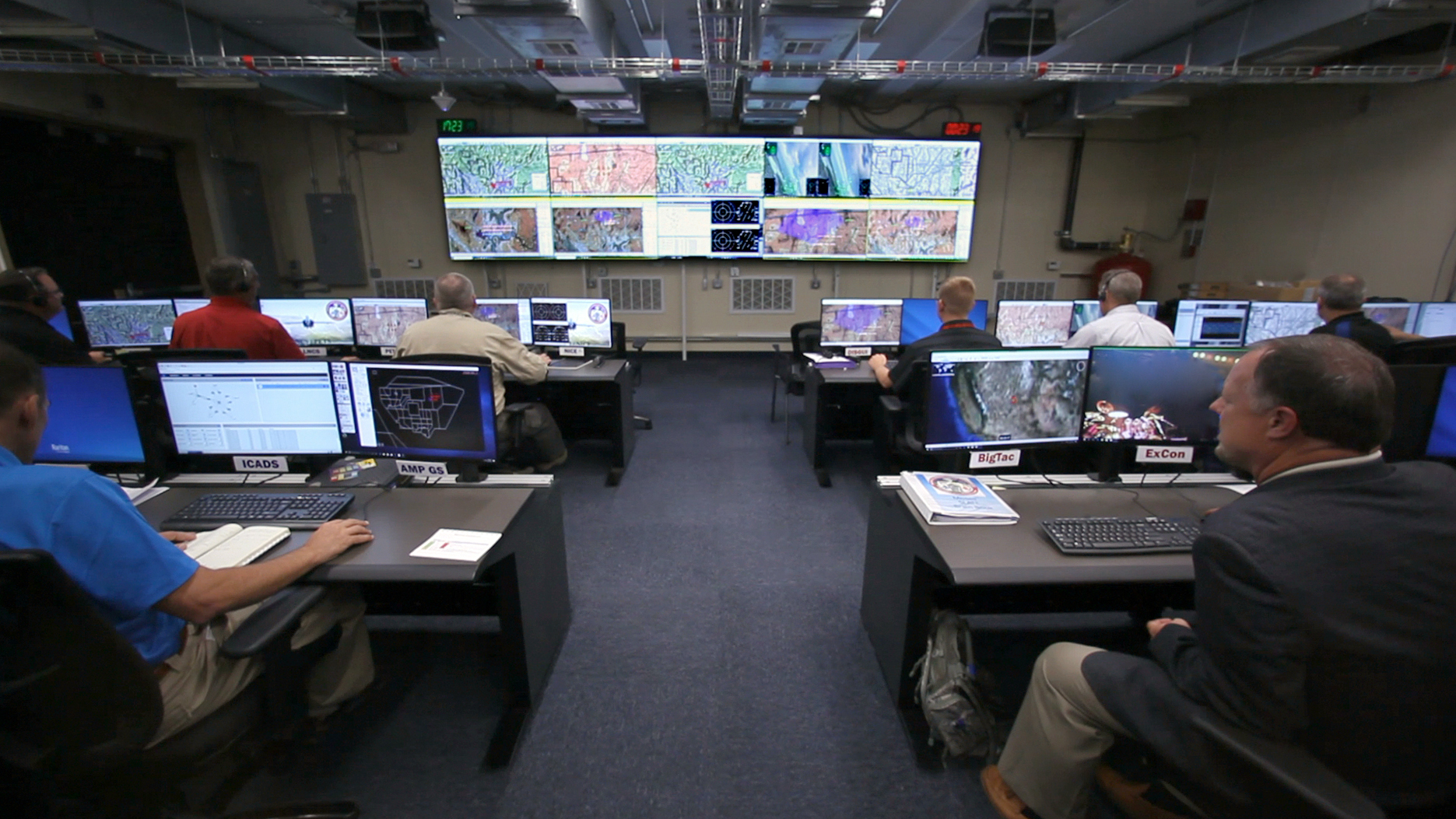
Both the U.S. Air Force and U.S. Navy have now carefully evaluated SLATE in detailed demonstrations. Both involved mixing real aircraft with simulators and computer-generated air targets mixed with ground-based air defense systems. The Navy went a step further and included a virtual/distributed helicopter Tactical Operational Flight Trainer and the Aegis Battle Force Tactical Trainer.
Further adoption of the system into fifth- and even sixth-generation platforms is a critical next step. There’s a major push to get this SLATE capability into the big manufacturers and make this system a baseline across all platforms.
SLATE is a versatile architecture and system that will enable varying threat presentations and behaviors that squadron aircrews will not have seen before, on a scale that simply wouldn’t be technically achievable or affordable if it was all live-action. It offers a tailored training environment that can be scaled up or back as required, ultimately testing aircrews, and allowing them to encounter a foe as they would see them in real combat.
Consider the cost of flying a full-up live 8-v-16 mission in a sophisticated integrated air defense system full of modern SAM systems for a dedicated training event, assuming you could even arrange to have all of the sophisticated threat systems or physical emulators available. The cost for that single event would be millions of dollars, with just the live F-15E and F-16 four-ships linked with the SLATE system, the cost for that event would be orders of magnitude less — with more realistic training.

The SLATE pod cleverly replicates every sensor the host aircraft has, and the magic is that the LVC processor tells the jet what to believe it is seeing. That early ACMI pod is so much more than a telemetry tracking system now. It knows there’s an F-16 out there guising as a J-20. The mission system also offers a library of repeatable missions — so crews can repeat them and get better.
Feedback from the SLATE demonstrations yielded some impressive comments from participants. “We saw Hornets show up as Su-27s in the radar,” said one pilot. “The scenarios being set up to give various types of threats and missile threats is a great concept and ability. Being able to fight against an air-to-air picture that we can’t normally support or train realistically to is beneficial.” However, there were some noted areas to improve upon in the constructive feedback, such as participants falling out of the LVC and some of the constructive entities not appearing on the Link 16 datalink ‘picture.’
One could imagine that the technology behind SLATE could be fused with other emerging fighter pilot training concepts, as well. The ability to project virtual elements, including adversary aircraft, visually into a pilot’s field of view is another cutting-edge area that could change how fighter pilots train. Integrating that technology, which you can read all about here and here, with the infrastructure that SLATE brings to the table, could potentially even solve the lack of actually seeing virtual and constructive elements visually for crews flying live missions. This could even allow for dogfighting against aircraft that aren’t really there.
Regardless of what could be on the horizon, Cubic underscores that SLATE is secure, which means the argument that all sensitive training needs to be completed in a ground-based simulator is simply not valid. Fighter jets don’t behave fully like simulators, and training effectively in real aircraft, flying real missions, is essential.
Blending the live with the virtual achieves both aims, which helps make the case that SLATE represents a revolution in air combat training.
Contact the editor: Tyler@thedrive.com
